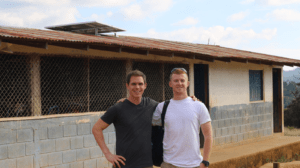
Rob Pinder, founder of NextClimate, is determined to take action on climate change through affordable renewable energy. NextClimate is a nonprofit based in North Carolina that helps provide cost-effective renewable energy to homeowners. Pinder has used NextClimate to launch several campaigns called SolarizeNC that have pushed for solar in various communities.
USI: Why solar?
Rob Pinder: Our mission at NextClimate is to help people take action on climate change in ways that strengthen communities. We looked around at different ways to do that, and solar is a powerful way for people to reduce their emissions by a lot. Also, it saves them money. Everything lines up very nicely with solar, for people putting in on their homes. There are other ways to reduce your electricity use and be more efficient, but we have been really excited about our Solarize programs because it makes a big difference that is measurable.
USI: What drove you to start NextClimate?
Pinder: I was really drawn to the idea of NextClimate because we’ve learned a ton about climate and there’s obviously a lot more to learn. We know there are challenges to be solved right now and we have the technologies to do it right now, but there’s a gap between people knowing about it and people doing something about it. So, I really wanted to help fill that gap, by making it easier for people to do something. There are a lot of magazines that show “here’s the top 10 green tips you can do,” and it’s like changing lightbulbs. And that’s good, people should change their lightbulbs, but we wanted to make it just as easy to improve your efficiency. I was really drawn to that goal because it seems like climate change is accelerating a lot more rapidly than we thought. So we need to do something now, and I wanted to be part of doing something about it now, instead of studying it and raising alarm about it.
USI: How are the Solarize programs connected to NextClimate?
Pinder: Solarize is a program that NextClimate runs. The whole idea behind Solarize started in 2009, when a bunch of neighbors got together in Portland, Oregon, and they said, “We don’t know much about solar, and it seems kind of expensive, but I bet if we all got together we could negotiate a better price from our local installer … ” It helps lower the social stigma. If all your neighbors are doing it, then you’re not the weird person with solar on your roof.
So they brought together the three forces that really made a big impact on the adoption of solar. And the Department of Energy saw what they did and funded a couple other pilot programs in other places, and out of that came a sort of handbook on how to do it in your town. So at the end of 2013, I saw the handbook and thought it was a great idea, and about the same time there were folks in Asheville thinking about the same idea, there were folks in Durham thinking about the same idea, and we started out all working independently, but over time ended up working very closely together and collaborating. Oftentimes, different nonprofits are kind of vying for the same space and they end up butting heads, but it has been really great having different groups with different expertise being able to share what works and what doesn’t, and resources and methods.
USI: Is Solarize a one-time thing, or do you plan to do it again in the future?
Pinder: Originally, we thought about it as just getting the pump primed, and once we got the pump primed the water would be flowing and take off. So we did that and doubled the number of installations in Orange County. But the state tax credit for renewables went away this year, so we’ve been thinking that we probably need to do another push. … So we’re gearing up for another campaign in 2016 and trying to be creative about other kinds of options we can help people with that make up some of that price difference that used to be there with the tax credit.
USI: Beyond just the benefit of renewable energy, what do you think is the value of the installations NextClimate has done at the schools in Carrboro?
Pinder: The renewable energy aspect is nice, but it’s actually really small — a school uses an enormous amount of power. But I think it really serves two purposes. One is sort of a reminder to the community. Here’s this technology that we have at the school, why doesn’t every school have it? Why doesn’t every house have it? And the second is a learning tool. We spent a lot of effort making sure that the amount of electricity being generated is pushed out onto the Internet, so you can view it on each panel. The one at McDougle is next to the middle school, which is next to the library and the elementary school, so when they have different events people go out and tour it. … The renewable energy part is nice, but I think the goal was to make it accessible for students, and hopefully inspire some of them.
USI: What else have you observed while working in the solar industry?
Pinder: Something that we’ve observed is that most of the people who’ve switched to solar buy it outright — they purchase the whole system upfront. And those people were also able to take advantage of tax credits. So, that tends to be people who have higher income or more savings. We’ve been working a lot on how to make this same opportunity available to people who aren’t in that situation. Lower income groups spend a much bigger chunk of their disposable income on energy, so if we can save those groups ten dollars a month on their electric bill, that’s a much bigger dent. So we’ve been thinking about the next phase and how to find that nexus between making energy more affordable and making energy more renewable. We have a couple programs in different stages of being ready, but they aren’t quite approved and ready to go. But that’s what we’re really excited about going forward, just trying to broaden the access to renewable energy as best we can.
Article: Lydia Odom



